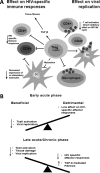Homeostasis and function of regulatory T cells in HIV/SIV infection
- PMID: 22811537
- PMCID: PMC3457299
- DOI: 10.1128/JVI.00993-12
Homeostasis and function of regulatory T cells in HIV/SIV infection
Abstract
Regulatory T cells (Tregs) play a pivotal role in the maintenance of tolerance as well as in the control of immune activation, particularly during chronic infections. In the setting of HIV infection, the majority of studies have reported an increase in Treg frequency but a decrease in absolute number in all immune compartments of HIV-infected individuals. Several nonexclusive mechanisms have been postulated to explain this preferential Treg accumulation, including peripheral survival, increased proliferation, increased peripheral conversion, and tissue redistribution. The role played by Tregs during HIV infection is still poorly understood, as two opposing hypotheses have been proposed. A detrimental role of Tregs during HIV infection was suggested based on the evidence that Tregs suppress virus-specific immune responses. Conversely, Tregs could be beneficial by limiting immune activation, thus controlling the availability of HIV targets as well as preventing immune-based pathologies. Despite the technical difficulties, getting a better understanding of the mechanisms regulating Treg dynamics remains important, as it will help determine whether we can successfully manipulate Treg function or number to the advantage of the infected host. The aim of this review is thus to discuss the recent findings on Treg homeostasis and function in the setting of HIV infection.
Figures


References
-
- Andersson J, et al. 2005. The prevalence of regulatory T cells in lymphoid tissue is correlated with viral load in HIV-infected patients. J. Immunol. 174:3143–3147 - PubMed
Publication types
MeSH terms
Substances
Grants and funding
LinkOut - more resources
Full Text Sources
Medical

